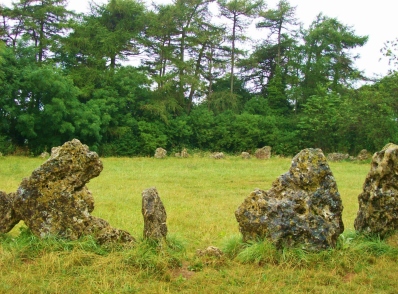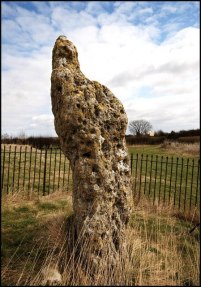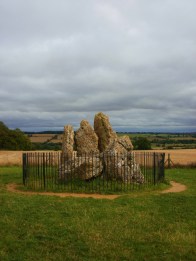
The King’s Men
On the borders of the English counties of Warwickshire and Oxfordshire, not far from the village of Long Compton, lies a mysterious complex of Neolithic and Bronze Age megaliths known as the Rollright Stones. Presented here is a brief description of the stone complex followed by a look at the petrification myth associated with it that fancifully attempts to explain its origin. The presentation concludes by briefly mentioning other stone circles and monoliths that also have petrification myths associated with them.
The Rollright Stones
The Rollright Stones complex consists of three sets of monuments; the King Stone, the Whispering Knights and the King’s Men. The King Stone is a single standing stone set some 50 yards outside the stone ring which is separated from it by a road. The Whispering Knights was a burial chamber also outside the stone ring. The final set is a circle of stones called the King’s Men.
The sets are not the same age as each other and all appear to have had different purposes. This leads scholars to think that the site had a strong tradition of ritual over a long period of time and had some kind of special significance during that time. With the timescale involved and the sheer mystery of their purpose perhaps it’s not surprising that a number of intriguing myths and legends have evolved as people throughout the ages attempted to explain their existence.
The Petrified King and his knights

The King Stone – Photo by Cameraman
According to a legend recorded by William Camden in 1610, and put into verse, there was a king who wanted to conquer the entire country of England and he came across a witch who confronted him saying,
“Seven long strides shalt thou take And if Long Compton thou canst see, King of England thou shalt be.”
The King took up the challenge saying in reply,
“Stick, stock, stone As King of England I shall be known.”
And strode forward, but on his seventh stride a long mound, which sometimes now is known as the Arch-Druid’s barrow rose up before him preventing the sight of Long Compton. The laughing witch cried,
“As Long Compton thou canst not see King of England thou shalt not be. Rise up stick and stand still stone For King of England thou shalt be none; Thou and thy men hoar stones shall be And I myself an eldern tree.”
The King was turned into a standing stone known as the King Stone and most of his men who were gathered in a circle were turned into the King’s Men ring of stones. Outside of this circle was a small group of knights who some say were in prayers, while others say they were whispering and plotting against the king. Either way they still fell victim and were turned to stone to become Whispering Knights.

Whispering Knights – by Midnightblueowl
A legend says that one day the spell will be broken and the King and his knights will resume their conquest of England unless they have the bad luck to come across another witch. It is not told if the king had angered the witch in some way. Neither is it known why the witch turned herself into an elder tree unless it was to keep an eye on the hapless king. The witch’s tree is said to be growing in a hedge separating the King Stone from the Stone Circle and according to legend will bleed if it is cut when in flower. It is said that on Midsummer’s Eve people would congregate around the King Stone and he would move his head when the elder tree was cut.
Midnight at the stones
Tradition says the King’s Men are released from the petrification spell and return to life at midnight. They all join hands together and dance in a circle and are also said to go down to the spring in a nearby spinney to take a drink. This is a dangerous time because it is said that anyone who should witness these extraordinary events will die or go mad.
Petrification myths
Many other stone circles and standing stones have petrification myths attached to them that tell how people were turned to stone by a witch, God, or the Devil for taking part in some forbidden activity in some way. Some people think these type of legends were encouraged by the Christian church who were keen to discourage pagan practices. Another school of thought was that such legends were promoted by the Puritans as a warning to keep on the straight and narrow path of the Christian faith.
The threat of petrification may have been seen as a lasting and very visible punishment for transgressing the rules, especially those of merrymaking on Sundays which seems to be a popular day for being turned to stone in Britain! In the case of the Rollright Stones we are not told what the day was only that it was a witch that gave the king the warning and appears to have foretold the king’s destiny, or cast the spell that fulfilled it.
Was it misfortune, or just a bad day?
The petrification of humans into stone is often associated with the creation of stone circles and standing stones. Many other ancient stone circles and monoliths also have petrification myths attached to them such as Long Meg and her Daughters in Cumbria, Mitchell’s Fold in Shropshire, the Stanton Drew stone circles of Somerset, the Merry Maidens and The Hurlers, Cornwall and there are plenty of other examples in the British Isles and around the world. In Britain the petrification is often caused by a witch, or for participating in some forbidden activity such as merrymaking on a Sunday. In the case of the Rollright Stones the King and his men just seemed to have had the misfortune to happen upon a particularly spiteful witch, or just caught her on a bad day!
© 11/07/2016 zteve t evans
References and Attributions
Copyright July 7th, 2016 zteve t evans
- George Lambrick “The Rollright Stones” (pamphlet) 1983
- Janet and Colin Bord “Mysterious Britain” 1974 Ed.
- Chris Morgan “Strange Oxford” 1987
- Doreen Valiente “An ABC of Witchcraft” 1996
- Mark Turner “Folklore & Mysteries of the Cotswolds” 1993
- Some folklore is assembled by Arthur J. Evans, “The Rollright Stones and their folk-lore”, Folk-Lore 6 (1895:18f.
- Myths and legends | The Rollright Stones
- Rollright Stones | English Heritage
- Rollright Stones – Wikipedia
- Legends of the Rollright Stones, Oxfordshire (Article)
- File:The Rollright Stones, the Kings Men.JPG From Wikimedia Commons – The King’s Men, Rollright Stones – Poliphilo – CC0
- File:Rollright Stones, the King Stone – geograph.org.uk – 1598710.jpg From Wikimedia Commons – Rollright Stones, the King Stone – Photo by Cameraman – CC BY-SA 2.0
- File:Whispering Knights.jpg From Wikimedia Commons – The Whispering Knights – By Midnightblueowl – CC BY-SA 3.0

Pingback: The Elder Mother, a mystery – WE ARE STAR STUFF
Thanks!
I enjoyed this post. After reading this, I already have ideas to use standing stones and the myths around it in my writing…
Thanks, Ronel, very much appreciated and look forward to see your ideas!
Interesting stuff – I’ve been doing a lot of research on petrification myths would be good to chat with you sometime!
Thanks appreciated! Happy to chat, you might like this one too English Folktales: The White Cow of Mitchell’s Fold, on my blog
Well, Zteve, here we are again with stone appearing in a folktale (or myth). I can see a cheeky travel catchphrase forming around a campaign: Come to England. We have major stones! 🙂
We do but be careful not to upset any witches!
Fascinating post
Thank you!
Good post, and well told. I thought of the hurlers and the merry maidens as I read it.
Thank you!
Interesting post. I visited Long Meg and her Daughters last year and blogged about it. It was a very atmospheric place.
Interesting, thanks I’ll check it out!
Pingback: July Little Treasures – Cultivating Time
Thank you!
Hi Zteve, I visited the Rollright Stones many years ago and have been fascinated with them ever since. However, I did not know the history of them, so thank you for this interesting post. Its a fascinating story.
Hi Rita, I have always been intrigued by these and other kinds of ancient places. Always curious about the thinking behind them though I don’t suppose we will ever know. Thanks for commenting, appreciated!
Pingback: Petrification Myths: Saints, Snakes and Ammonites – Under the influence!
I wonder if the witch changed into an elder tree because in some theories of magic, you always have to sacrifice something to achieve the desired result. In this case, she sacrificed herself.
That’s an interesting theory, thanks!
Thanks again Zteve for this fascinating story. I know I have read it before it’s so interesting.
Thank you, appreciated!